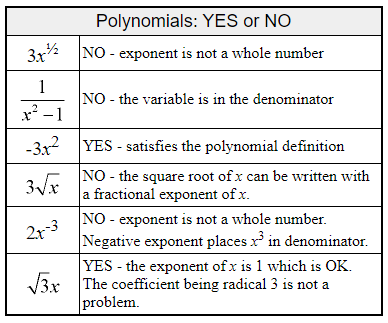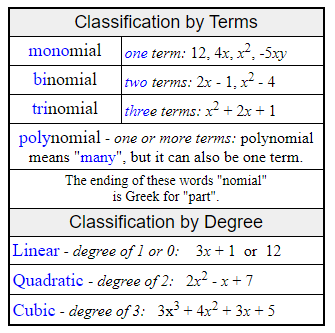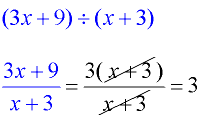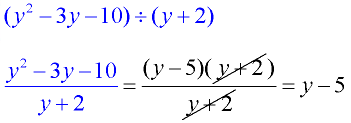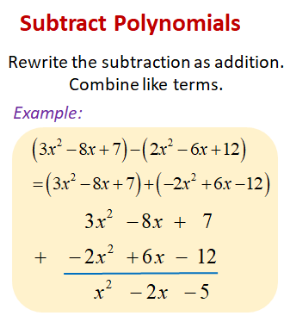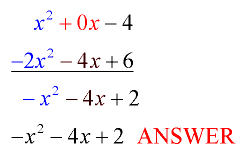Factorise A Polynomial By Splitting The Middle Term Example Problems With Solutions
Type I: Factorization of Quadratic polynomials of the form x2 + bx + c.
(i) In order to factorize x2 + bx + c we have to find numbers p and q such that p + q = b and pq = c.
(ii) After finding p and q, we split the middle term in the quadratic as px + qx and get desired factors by grouping the terms.
Example 1: Factorize each of the following expressions:
(i) x2 + 6x + 8 (ii) x2 + 4x –21
Solution:
(i) In order to factorize x2 + 6x + 8, we find two numbers p and q such that p + q = 6 and pq = 8.
Clearly, 2 + 4 = 6 and 2 × 4 = 8.
We know split the middle term 6x in the given quadratic as 2x + 4x, so that
x2 + 6x + 8 = x2 + 2x + 4x + 8
= (x2 + 2x) + (4x + 8)
= x (x + 2) + 4 (x+ 2)
= (x + 2) (x + 4)
(ii) In order to factorize x2 + 4x – 21, we have to find two numbers p and q such that
p + q = 4 and pq = – 21
Clearly, 7 + (– 3) = 4 and 7 × – 3 = – 21
We now split the middle term 4x of
x2 + 4x – 21 as 7x – 3x, so that
x2 + 4x – 21 = x2 + 7x – 3 x – 21
= (x2 + 7x) – (3x + 21)
= x (x + 7) – 3 (x + 7) = (x + 7) (x – 3)
Example 2: Factorize each of the following quadratic polynomials: x2 – 21x + 108
Solution: In order to factorize x2 – 21x + 108,
we have to find two numbers such that their sum is – 21 and the product 108.
Clearly, – 21 = – 12– 9 and – 12 × – 9 = 108
x2 – 21 x + 108 = x2 – 12 x – 9x + 108
= (x2 – 12 x) – (9x– 108)
= x(x – 12) – 9 (x – 12) = (x–12) (x – 9)
Example 3: Factorize the following by splitting the middle term : x2 + 3 √3 x + 6
Solution: In order to factorize x2 + 3 √3 x + 6, we have to find two numbers p and q such that
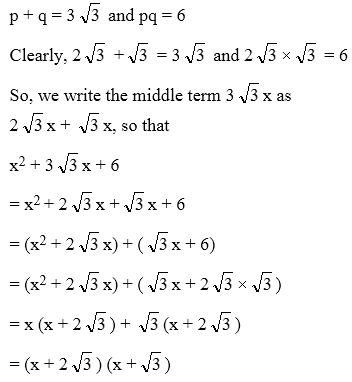
Type II: Factorization of polynomials reducible to the form x2 + bx + c.
Example 4: Factorize (a2 – 2a)2 – 23(a2 – 2a) + 120.
Solution:

Example 5: Factorize the following by splitting the middle term x4– 5x2 + 4
Solution:
Let x2 = y. Then, x4 – 5x2 + 4
= y2 – 5 y + 4
Now, y2 – 5 y + 4
= y2 – 4y – y + 4
= (y2 – 4y) – (y – 4)
= y(y –4) – (y– 4)
= (y – 4) (y – 1)
Replacing y by x2 on both sides, we get
x4 – 5x2 + 4 = (x2–4) (x2 – 1)
= (x2–22) (x2 – 12) = (x–2) (x+2) (x – 1) (x + 1)
Example 6: Factorize (x2 – 4x) (x2 – 4x – 1) – 20
Solution:
The given expression is
(x2 – 4x) (x2 – 4x – 1) – 20
= (x2 – 4x)2 – (x2 – 4x) – 20
Let x2 – 4x = y . Then,
(x2 – 4x)2 – (x2 – 4x) – 20 = y2 – y – 20
Now, y2 – y – 20
= y2 –5 y + 4y – 20
= (y2 – 5 y) + (4y– 20)
= y (y – 5) + 4 (y – 5)
= (y – 5) (y + 4)
Thus, y2 – y – 20 = (y – 5) (y + 4)
Replacing y by x2 – 4x on both sides, we get
(x2 – 4x)2 – (x2 – 4x) – 20
= (x2 – 4x – 5) (x2 – 4x +4)
= (x2 – 5x + x – 5) (x2 – 2 × x × 2 + 22)
= {x (x – 5) + (x – 5)} (x – 2)2
= (x – 5) (x + 1) (x – 2)2
Type III: Factorization of Expressions which are not quadratic but can factorized by splitting the middle term.
Example 7: If x2 + px + q = (x + a) (x + b), then factorize x2 + pxy + qy2.
Solution: We have,
x2 + px + q = (x + a) (x + b)
⇒ x2 + px + q = x2 + x(a + b) + ab
On equating the coefficients of like powers of x, we get
p = a + b and q = ab
∴ x2 + pxy + qy2 = x2 + (a + b)xy + aby2
= (x2 + axy) + (bxy + aby2)
= x(x + ay) + by(x + ay)
= (x + ay) (x + by)
Example 8: Factorize the following expression x2y2 – xy – 72
Solution:
In order to factorize x2y2 – xy – 72, we have to find two numbers p and q such that
p+ q = – 1 and pq = – 72
clearly, – 9 +8 = – 1 and – 9 × 8 = – 72.
So, we write the middle term – xy of
x2y2 – xy – 72 as – 9 xy + 8 xy, so that
x2y2 – xy – 72 = x2y2 – 9 xy + 8 xy – 72
= (x2y22 – 9xy) + (8xy – 72)
= xy (xy – 9) + 8 (xy – 9)
= (xy – 9) (xy + 8)
Factorization Of Polynomials Of The Form ax2 + bx + c, a ≠ 0, 1
Type I: Factorization of quadratic polynomials of the form ax2 + bx + c, a 0, 1
(i) In order to factorize ax2 + bx + c. We find numbers l and m such that l + m = b and lm = ac
(ii) After finding l and m, we split the middle term bx as lx + mx and get the desired factors by grouping the terms.
Example 9: Factorize the following expression
6x2 – 5 x – 6
Solution: The given expression is of the form ax2+ bx+c, where, a = 6, b = – 5 and c = –6.
In order to factorize the given expression, we have to find two numbers l and m such that
l + m = b = i.e., l + m = – 5
and lm = ac i.e. lm = 6 × – 6 = – 36
i.e., we have to find two factors of – 36
such that their sum is – 5. Clearly,
– 9 + 4 = – 5 and – 9 × 4 = – 36
l = – 9 and m = 4
Now, we split the middle term – 5x of
x2 – 5x – 6 as – 9 x + 4x, so that
6x2 – 5x – 6 = 6x2–9x + 4x – 6
= (6x2 – 9x) + (4x – 6)
= 3x (2x – 3) + 2(2x – 3) = (2x – 3) (3x + 2)
Example 10: Factorize each of the following expressions:
(i) √3 x2 + 11x + 6 √3
(ii) 4 √3 x2 + 5x – 2 √3
(iii) 7 √2 x2 – 10 x – 4 √2
Solution: (i) The given quadratic expression is of the form ax2 + bx + c,
where a = √3, b = 11 and c = 6 √3.
In order to factorize it, we have to find two numbers l and m such that




Example 11: Factorize the following by splitting the middle term
1/3 x2 – 2x – 9
Solution:
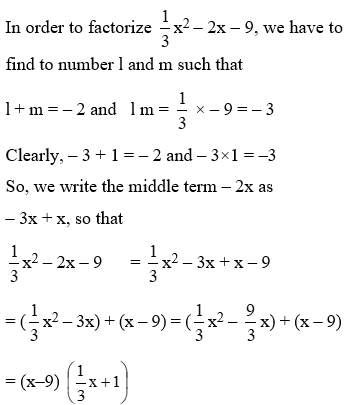
Type II: Factorization of trinomial expressions which are not quadratic but can be factorized by splitting the middle term.
Example 12: Factorize the following trinomial by splitting the middle term
8a3 – 2a2b – 15 ab2
Solution: Here a3 × ab2 = (a2b)2 i.e., the product of the variables in first and last term is same as the square of the variables in the middle term. So, in order to factorize the given trinomial, we split the middle term
– 2a2b as – 12a2b + 10 a2b , so that
8a3 – 2a2b – 15 ab2
= 8a3 –12a2b +10 a2b–15 ab2
= 4a2(2a – 3b) + 5 ab (2a – 3b)
= (2a – 3b) (4a2 + 5ab)
= (2a – 3b) a (4a + 5b)
= a (2a – 3 b) (4a + 5b)
Type III : Factorization of trinomial expressions reducible to quadratic expressions.
Example 13: Factorize each of the following expressions by splitting the middle term :
(i) 9(x – 2y)2– 4(x – 2y) – 13
(ii) 2(x + y)2 – 9(x + y) – 5
(iii) 8(a + 1)2 + 2(a + 1) (b + 2) – 15(b + 2)2
Solution: (i) The given expression is 9(x – 2y)2 – 4(x – 2y) – 13.
Putting x – 2y = a, we get
9(x – 2y)2 – 4(x – 2y) – 13 = 9a2 – 4a – 13
Now, 9a2 – 4a – 13 = 9a2 – 13a + 9a – 13
= (9a2 – 13a) + (9a – 13)
= a(9a – 13) + (9a – 13)
= (a + 1) (9a – 13)
Replacing a by x – 2y on both sides, we get
9(x – 2y)2 – 4(x – 2y) – 13
= (x – 2y + 1) {9(x – 2y) – 13}
= (x – 2y + 1) (9x – 18y – 13)
(ii) The given expression is
2(x + y)2 – 9(x + y) – 5
Replacing x + y by a in the given expression, we have
2(x + y)2 – 9(x + y) – 5 = 2a2 – 9a – 5
Now, 2a2 – 9a – 5 = 2a2 – 10a + a – 5
= (2a2 – 10a) + (a – 5)
= 2a(a – 5) + (a – 5) = (a – 5) (2a + 1)
Replacing a by x + y on both sides, we get
2(x + y)2 – 9(x + y) – 5
= (x + y – 5) {2(x + y) + 1}
= (x + y – 5) (2x + 2y + 1).
(iii) The given trinomial is
8(a + 1)2 + 2(a + 1) (b + 2) – 15(b + 2)2
Putting a + 1 = x and b + 2 = y, we have
8(a + 1)2 + 2(a + 1) (b + 2) – 15(b + 2)2
= 8x2 + 2xy – 15y2
= 8x2 + 12xy – 10xy – 15y2
= 4x(2x + 3y) – 5y(2x + 3y)
= (2x + 3y) (4x – 5y)
Replacing x by a + 1 and y by b + 2, we get
8(a + 1)2 + 2(a + 1) (b + 2) – 15(b + 2)2
= {2(a + 1) + 3(b + 2)} {4(a + 1) – 5(b +2)}
= (2a + 3b + 8) (4a – 5b – 6)











